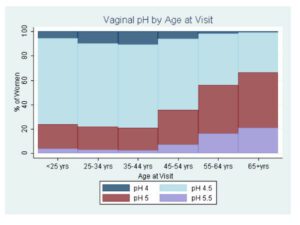
Maintaining vaginal pH is essential for vaginal health. Fortunately, there are several natural remedies to help restore vaginal pH balance. When the pH balance is disrupted, the vagina becomes susceptible to infections. An overly alkaline environment can encourage the growth of harmful microbes, leading to various issues, while excessive acidity can also pose risks to reproductive health. Read on to discover how to naturally restore vaginal pH.
what’s A Normal Vaginal pH?
The vaginal environment is naturally acidic, with a normal pH of less than 4.5. The pH scale measures acidity and alkalinity, with 7 being neutral, values above 7 indicating alkaline, and those below 7 signifying acidity. Throughout a woman’s lifetime, vaginal pH levels may naturally fluctuate. During reproductive years, the ideal vaginal pH typically falls between 3.8 and 4.5. However, before the first menstrual cycle and after menopause, it’s normal for vaginal pH to be slightly higher than 4.5.
Lactobacilli, friendly bacteria inhabiting the vagina, play a vital role in maintaining acidity by producing lactic acid and hydrogen peroxide. This acidic environment is essential for protecting against harmful bacteria and fungi.
Nonetheless, various factors can disrupt the natural vaginal pH balance, causing it to become more alkaline. Detecting such a change is crucial, as an alkaline environment can increase the risk of vaginal infections.

The graph shows that the average vaginal pH level changes throughout a woman’s lifetime.
- Newborn: 7.0-7.5
- Infancy: 7.0-7.5
- Childhood: 7.0-7.5
- Prepuberty: 7.0-7.5
- Puberty: 4.5-5.5
- Reproductive years: 4.5-5.5
- Menopause and post-menopause: 5.5-6.5
The vaginal pH level can be affected by a number of factors, including:
- Age: The vaginal pH level tends to become more alkaline (less acidic) as a woman gets older. This is because the levels of estrogen, a hormone that helps to maintain the vaginal pH level, decline after menopause.
- Menstruation: The vaginal pH level can become more alkaline during menstruation. This is because menstrual blood is alkaline.
- Douching: Douching can disrupt the natural balance of bacteria in the vagina and raise the vaginal pH level.
- Sex: Sex can also raise the vaginal pH level. This is because semen is alkaline.
- Infections: Vaginal infections, such as bacterial vaginosis and yeast infections, can also raise the vaginal pH level.
How Can I Test My Vaginal pH?

Several home testing kits are available on the market to measure vaginal pH. These kits often include pH test strips that change color when held against the vaginal wall for a specific duration. Afterward, you can compare the strip’s color with the provided chart, which assigns values to different shades, helping you determine your vaginal pH level.
It’s essential to follow the instructions provided with the test kit, as they specify the duration of strip contact with the vaginal wall and the appropriate conditions for testing.
Vaginal pH Imbalance Symptoms
Changes in Discharge Color and Texture
Normally, vaginal discharge appears as a clear or whitish gel-like fluid. An imbalance in vaginal pH can cause noticeable changes in the color and texture of your discharge. It may turn yellow, gray, or milky white and take on a curdled, cottage cheese-like texture.
Changes in Discharge Odor
Healthy vaginal discharge is typically odorless or has a very subtle scent. However, when there’s a pH imbalance, the discharge may emit a strong, unpleasant odor.
Itchiness and Discomfort
An imbalanced vaginal pH can lead to itchiness and discomfort in and around the vaginal opening. You may experience a burning sensation while urinating or during sexual intercourse.
These symptoms often arise due to bacterial or yeast infections that can develop in the absence of the vagina’s natural acidic environment. Let’s delve further into what happens when your vaginal pH balance is disrupted.
What Happens When Your Vaginal pH Balance Is Off?

Bacterial Vaginosis
Bacterial vaginosis occurs when there is an overgrowth of bacteria in the vagina. It’s characterized by a fishy or foul-smelling vaginal discharge, which can be gray, yellow, or white. Additionally, it may cause discomfort, itchiness, or a burning sensation in the vaginal area.
Trichomoniasis
Trichomoniasis, or trich, is a common sexually transmitted infection caused by the parasite Trichomonas vaginalis. Symptoms often include a yellowish-green frothy discharge, severe itching, painful urination, and small red dots on the cervix. This infection also elevates the risk of cervical cancer and pregnancy complications.
Increased Risk of Serious Infections
Conditions like bacterial vaginosis and trichomoniasis can heighten the risk of contracting more severe diseases and infections, including HIV, HPV (human papillomavirus), and herpes simplex virus.
Yeast Infection
Vaginal yeast infections are primarily caused by an overgrowth of the Candida fungus. While Candida naturally resides in the vagina, overgrowth can lead to infection, resulting in itchiness, discomfort, vaginal discharge, and pain during sexual intercourse or urination. Research suggests that Candida infection may increase the risk of HIV.
Urinary Tract Infections (UTIs)
Imbalanced vaginal pH levels can pave the way for urinary tract infections (UTIs). Women in menopause face a greater risk of UTIs as their pH levels tend to be slightly higher than 4.5.
Reduced Fertility
The weakly acidic environment of the vagina plays a crucial role in safeguarding sperm mobility by preventing the colonization of harmful pathogens. Different bacteria can attach to sperm, reducing their chances of reaching the egg. The presence of pathogens in the vagina also heightens the risk of inflammation and infection, both of which can affect fertility.
Natural Remedies To Restore Your Vaginal pH

Increase Probiotic Intake
Probiotics, as the name suggests, promote the growth and multiplication of friendly bacteria, especially lactobacilli, which help restore the pH balance of your vagina. You can either take probiotic supplements or consume probiotic-rich foods like yogurt, kimchi, sauerkraut, tempeh, kombucha, and miso to support vaginal health.
Stop Douching and Use Only Mild and Suitable Intimate Products
To restore your pH balance, it’s essential to discontinue douching. Douching involves rinsing the vagina with an upward stream of water or a mixture of water and various substances like vinegar, baking soda, antiseptics, or iodine. This practice can disrupt vaginal pH balance and negatively impact reproductive health. Instead, use warm water to gently clean the outer area of the vagina or opt for intimate wash products specially designed to maintain vaginal pH balance.
Ensure Adequate Airflow to Your Vagina and Vulva
Proper airflow is essential to reduce humidity levels in the vaginal area, preventing the growth of harmful bacteria and yeast. Wear lightweight and breathable cotton underwear, and consider sleeping without underwear to promote aeration.
Use Condoms or Other Barriers During Intercourse
Semen can neutralize the acidic environment of your vagina. If you’re not planning to conceive, using a condom or another barrier method during intercourse can help maintain vaginal pH balance.
Use Antibiotics Wisely
Antibiotics target bacteria, including both beneficial and harmful ones. This can disrupt the vaginal flora, which plays a role in maintaining vaginal pH balance. If possible, avoid frequent antibiotic use, or consider taking probiotics alongside antibiotics to support your vaginal health.
Change Tampons Frequently During Menstruation
Blood has a slightly alkaline pH, which can affect your vaginal pH balance. Avoid leaving tampons or sanitary pads in place for extended periods during menstruation, as stagnant blood may increase vaginal pH. Regularly switch out tampons or pads to help maintain the proper pH balance in the vaginal environment.
Additionally, you can make dietary adjustments to enhance your vaginal health.
What Can I Drink to Help Maintain My pH Balance?
Probiotics and antioxidants have shown a positive correlation with vaginal microbiome health, which contributes to maintaining the vaginal pH balance. While more research is needed to fully understand the efficacy of oral probiotics and antioxidants, here are some drinks that may help restore vaginal pH balance:
- Soy milk
- Cranberry juice
- Pickle juice
- Kefir
- Lemon-infused water
You can also consume pickled vegetables like gherkins and cucumbers, as they are excellent sources of probiotic bacteria.In certain situations, dietary changes and natural remedies may be insufficient, and it’s essential to know when to consult a doctor.
When To See a Doctor

In general, the vagina can often restore its health with the help of natural remedies to restore vaginal pH balance. However, seek medical attention if any of the following symptoms do not improve or worsen:
Persistent foul-smelling discharge
Severe itching or discomfort
Pain during urination or sexual intercourse
Unusual changes in vaginal color or texture
Symptoms of sexually transmitted infections (STIs)
Fever or chills
Abnormal vaginal bleeding or spotting
Pelvic pain or discomfort
FAQ’s
What pH level is a yeast infection?
A yeast infection is associated with an increase in pH levels, often exceeding the normal acidic range of the vagina. Levels may rise above 4.5.
Is 6.0 a good pH balance?
A pH balance of 6.0 is slightly acidic but generally considered within the normal range. However, for the vagina, the optimal pH is typically more acidic, around 3.8 to 4.5.
Does cranberry juice help pH balance?
Cranberry juice is believed to support urinary tract health, but its direct impact on vaginal pH balance is limited. Maintaining a healthy diet and hydration may indirectly contribute to pH balance.
How do you know if your pH balance is off?
Changes in vaginal discharge, odor, or discomfort may indicate an off pH balance. If you suspect an issue, consult with a healthcare professional.
Can you smell if your pH balance is off?
Yes, an unusual or unpleasant odor may be a sign of an imbalance in vaginal pH, potentially indicating an infection or other issues.
Can your pH balance be off without BV?
Yes, an off pH balance can occur without bacterial vaginosis (BV). Various factors, including diet, sexual activity, or hormonal changes, can impact pH.
What throws off a woman’s pH balance?
Factors like douching, certain medications, hormonal changes, sexual activity, and an unhealthy diet can disrupt a woman’s vaginal pH balance.
What soap helps with pH balance?
Using a mild, fragrance-free, and pH-balanced soap specifically designed for intimate areas can help maintain the natural pH balance of the vagina.
What is the whiff test?
The whiff test is a diagnostic method where a sample is mixed with potassium hydroxide, and the odor is assessed. It’s commonly used to detect bacterial vaginosis.
How can I fix my pH balance overnight?
Overnight fixes are limited, but maintaining a healthy lifestyle, staying hydrated, using pH-balanced products, and avoiding irritants can contribute to restoring balance over time. If issues persist, consult a healthcare professional.
